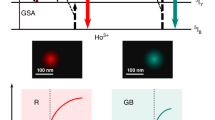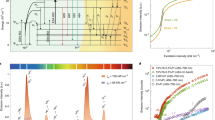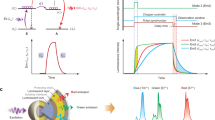Abstract
Photon avalanche (PA) can generate upconversion luminescent emission that grows steeply as a function of excitation power, effectively exhibiting a high order of nonlinearity (N) that is attractive for applications ranging from photophysics studies to biophotonics. Besides the limitations in available material systems, PA is typically sustained by a single reservoir level, limiting the ability to modulate the chromaticity of the emission as well as leading to small values of N and large excitation thresholds. Here we report a parallel PA mechanism in holmium (Ho3+)-doped nanoparticles for tunable emission at room temperature. The intermediate 5I7 and 5I6 levels of Ho3+ serve as dual reservoir levels that create two parallel energy loops. This activates multiple emissive levels and enables red, green and blue PA emission under 965 nm continuous-wave excitation. By rationally engineering transition kinetics through controlling doping concentration and core/shell configuration, we demonstrate multicolour PA with large N values of 17–22 and mild excitation threshold of ~22 kW cm−2. Moreover, emission can be tailored from almost pure red to intense red, green and blue by modifying the host lattice and introducing additional cross-relaxation pathways by doping with Ce3+/Tm3+. When using the nanoparticles to label biological cells, we demonstrate multicolour imaging on a single-continuous-wave-beam microscope with lateral spatial resolution of 78 nm and 102 nm in the green–blue and red channel, respectively. These findings open the way for manufacturing nonlinear multicolour fluorophores for versatile optical and biological applications.
This is a preview of subscription content, access via your institution
Access options
Access Nature and 54 other Nature Portfolio journals
Get Nature+, our best-value online-access subscription
$32.99 / 30 days
cancel any time
Subscribe to this journal
Receive 12 print issues and online access
$259.00 per year
only $21.58 per issue
Buy this article
- Purchase on SpringerLink
- Instant access to full article PDF
Prices may be subject to local taxes which are calculated during checkout





Similar content being viewed by others
Data availability
The data that support the findings of this work are available within the article. Source data are provided with this paper.
Code availability
The codes for numerical simulations of this study are available from the corresponding authors upon reasonable request.
References
Xomalis, A. et al. Detecting mid-infrared light by molecular frequency upconversion in dual-wavelength nanoantennas. Science 374, 1268–1271 (2021).
Zheng, Q. et al. Frequency-upconverted stimulated emission by simultaneous five-photon absorption. Nat. Photon. 7, 234–239 (2013).
Kallepalli, D. L. N. et al. Ultra-high density optical data storage in common transparent plastics. Sci. Rep. 6, 26163 (2016).
Pan, J.-A. et al. Ligand-assisted direct lithography of upconverting and avalanching nanoparticles for nonlinear photonics. J. Am. Chem. Soc. 146, 7487–7497 (2024).
Streich, L. et al. High-resolution structural and functional deep brain imaging using adaptive optics three-photon microscopy. Nat. Methods 18, 1253–1258 (2021).
Auzel, F. Upconversion and anti-Stokes processes with f and d ions solids. Chem. Rev. 104, 139–173 (2004).
Chivian, J. S., Case, W. E. & Eden, D. D. The photon avalanche: a new phenomenon in Pr3+ based infrared quantum counters. Appl. Phys. Lett. 35, 124–125 (1979).
Lee, C. et al. Giant nonlinear optical responses from photon-avalanching nanoparticles. Nature 589, 230–235 (2021).
Liang, Y. et al. Migrating photon avalanche in different emitters at the nanoscale enables 46th-order optical nonlinearity. Nat. Nanotechnol. 17, 524–530 (2022).
Zhang, Z. et al. Tuning phonon energies in lanthanide-doped potassium lead halide nanocrystals for enhanced nonlinearity and upconversion. Angew. Chem. Int. Ed. 62, e202212549 (2023).
Meijerink, A. & Rabouw, F. T. Giant photon avalanches in tiny particles. Nature 589, 204–205 (2021).
Bednarkiewicz, A. & Szalkowski, M. Photon avalanche goes multicolour. Nat. Nanotechnol. 17, 440–442 (2022).
Chen, C. & Jin, D. Giant nonlinearity in upconversion nanoparticles. Nat. Photon. 16, 553–554 (2022).
Bednarkiewicz, A., Chan, E. M., Kotulska, A., Marciniak, L. & Prorok, K. Photon avalanche in lanthanide doped nanoparticles for biomedical applications: super-resolution imaging. Nanoscale Horiz. 4, 881–889 (2019).
Wang, B. et al. Visible-to-visible four-photon ultrahigh resolution microscopic imaging with 730-nm diode laser excited nanocrystals. Opt. Express 24, A302–A311 (2016).
Denkova, D. et al. 3D sub-diffraction imaging in a conventional confocal configuration by exploiting super-linear emitters. Nat. Commun. 10, 3695 (2019).
Bates, M., Huang, B., Dempsey, G. T. & Zhuang, X. Multicolour super-resolution imaging with photo-switchable fluorescent probes. Science 317, 1749–1753 (2007).
Wang, F. & Liu, X. Multicolour tuning of lanthanide-doped nanoparticles by single wavelength excitation. Acc. Chem. Res. 47, 1378–1385 (2014).
Skripka, A. et al. A generalized approach to photon avalanche upconversion in luminescent nanocrystals. Nano Lett. 23, 7100–7106 (2023).
Korczak, Z. et al. Sensitized photon avalanche nanothermometry in Pr3+ and Yb3+ co-doped NaYF4 colloidal nanoparticles. Low Temp. Phys. 49, 322–329 (2023).
Wnuk, A. et al. Infra-red to visible up-conversion in holmium-doped materials. J. Alloys Compd. 341, 353–357 (2002).
Lavín, V., Lahoz, F., Martín, I. R., Rodríguez-Mendoza, U. R. & Cáceres, J. M. Infrared-to-visible photon avalanche upconversion dynamics in Ho3+-doped fluorozirconate glasses at room temperature. Opt. Mater. 27, 1754–1761 (2005).
Rathaiah, M. et al. Photon avalanche upconversion in Ho3+-doped gallium nano-garnets. Opt. Mater. 39, 16–20 (2015).
Mai, H. X. et al. High-quality sodium rare earth fluoride nanocrystals: controlled synthesis and optical properties. J. Am. Chem. Soc. 128, 6426–6436 (2006).
Liu, G. K., Chen, Y. H. & Beitz, J. V. Photon avalanche up-conversion in Ho3+ doped fluoride glasses. J. Lumin. 81, 7–12 (1999).
Helmerich, D. A., Beliu, G., Matikonda, S. S., Schnermann, M. J. & Sauer, M. Photoblueing of organic dyes can cause artifacts in super-resolution microscopy. Nat. Methods 18, 253–257 (2021).
Xu, J., Tehrani, K. F. & Kner, P. Multicolour 3D super-resolution imaging by quantum dot stochastic optical reconstruction microscopy. ACS Nano 9, 2917–2925 (2015).
Teitelboim, A. et al. Energy transfer networks within upconverting nanoparticles are complex systems with collective, robust, and history-dependent dynamics. J. Phys. Chem. C 123, 2678–2689 (2019).
Levy, E. S. et al. Energy-looping nanoparticles: harnessing excited-state absorption for deep-tissue imaging. ACS Nano 10, 8423–8433 (2016).
Zhao, J. et al. Upconversion luminescence with tunable lifetime in NaYF4:Yb,Er nanocrystals: role of nanocrystal size. Nanoscale 5, 944–952 (2013).
Lu, Y. et al. Tunable lifetime multiplexing using luminescent nanocrystals. Nat. Photon. 8, 32–36 (2014).
Fischer, S., Bronstein, N. D., Swabeck, J. K., Chan, E. M. & Alivisatos, A. P. Precise tuning of surface quenching for luminescence enhancement in core–shell lanthanide-doped nanocrystals. Nano Lett. 16, 7241–7247 (2016).
Kwock, K. W. C. et al. Surface-sensitive photon avalanche behavior revealed by single-avalanching nanoparticle imaging. J. Phys. Chem. C 125, 23976–23982 (2021).
Rustom, A., Saffrich, R., Markovic, I., Walther, P. & Gerdes, H.-H. Nanotubular highways for intercellular organelle transport. Science 303, 1007–1010 (2004).
Rabouw, F. T. et al. Quenching pathways in NaYF4:Er3+,Yb3+ upconversion nanocrystals. ACS Nano 12, 4812–4823 (2018).
van Swieten, T. P. et al. A Ho3+-based luminescent thermometer for sensitive sensing over a wide temperature range. Adv. Opt. Mater. 9, 2001518 (2021).
Huang, P. et al. Lanthanide-doped LiLuF4 upconversion nanoprobes for the detection of disease biomarkers. Angew. Chem. Int. Ed. 53, 1252–1257 (2014).
Deng, R. et al. Temporal full-colour tuning through non-steady-state upconversion. Nat. Nanotechnol. 10, 237–242 (2015).
Wu, J., Ji, N. & Tsia, K. K. Speed scaling in multiphoton fluorescence microscopy. Nat. Photon. 15, 800–812 (2021).
Chen, H. et al. Sub-50-ns ultrafast upconversion luminescence of a rare-earth-doped nanoparticle. Nat. Photon. 16, 651–657 (2022).
Bao, G. et al. Enhancing hybrid upconversion nanosystems via synergistic effects of moiety engineered NIR dyes. Nano Lett. 21, 9862–9868 (2021).
Greybush, N. J. et al. Plasmon-enhanced upconversion luminescence in single nanophosphor-nanorod heterodimers formed through template-assisted self-assembly. ACS Nano 8, 9482–9491 (2014).
Lee, C. et al. Indefinite and bidirectional near-infrared nanocrystal photoswitching. Nature 618, 951–958 (2023).
Szalkowski, M. et al. Predicting the impact of temperature dependent multi-photon relaxation processes on the photon avalanche behavior in Tm3+:NaYF4 nanoparticles. Opt. Mater. X 12, 100102 (2021).
Bednarkiewicz, A., Chan, E. M. & Prorok, K. Enhancing FRET biosensing beyond 10 nm with photon avalanche nanoparticles. Nanoscale Adv. 2, 4863–4872 (2020).
Fardian-Melamed, N. et al. Infrared nanosensors of piconewton to micronewton forces. Nature 637, 70–75 (2025).
Skripka, A. et al. Intrinsic optical bistability of photon avalanching nanocrystals. Nat. Photon. 19, 212–218 (2025).
Acknowledgements
L.-D.S., C.-H.Y. and H.D. acknowledge the support from the National Natural Science Foundation of China (numbers 22031002, 21931001, 21927901 and 22205009) and the Ministry of Science and Technology of the People’s Republic of China (numbers 2022YFF0710001, 2023YFB3507101 and 2022YFB3503700). Q.Z. appreciates the support from the National Natural Science Foundation of China (numbers 62335008 and 62122028) and the Guangdong Basic and Applied Basic Research Foundation (number 2023B1515040018).
Author information
Authors and Affiliations
Contributions
H.D., L.-D.S. and C.-H.Y. conceived of this project, designed the experiments and wrote the paper. H.D., S.Q., Y.L., Z.Z., X.-Y.W., Y.N., X.G., Z.-Y.L., X.-F.Y., L.-D.S., Q.Z. and C.-H.Y. performed the experiments. L.-Q.G. and J.-W.Z. carried out the rate equation modelling. L.-D.S., Q.Z. and C.-H.Y. supervised this project. All authors contributed to data analysis, discussions and paper preparation.
Corresponding authors
Ethics declarations
Competing interests
The authors declare no competing interests.
Peer review
Peer review information
Nature Photonics thanks the anonymous reviewers for their contribution to the peer review of this work.
Additional information
Publisher’s note Springer Nature remains neutral with regard to jurisdictional claims in published maps and institutional affiliations.
Extended data
Extended Data Fig. 1 PPA mechanism of Ho3+.
The 5I7 level is populated multiplicatively by CR, and serve as the reservoir level in the generation of red PA emission. The 5I6 level is populated via the cooperation of multiple CRs along with proper NRs, and serve as the reservoir level in the generation of green PA emission. The blue PA emission can be generated through additional ESAs and CRs, some of which are participated by the two reservoir levels.
Extended Data Fig. 2 Bright field and PA luminescence imaging of two BS-C-1 cells labelled with Ho3+-doped nanoparticles.
(a–d) Bright field (a), red (R) emission channel (b), green/blue (GB) emission channel (c), and overlay (d) images. Phalloidin-modified LLF:Ho,Ce@LYF nanoparticles were used for targeting the intercellular actin filaments (tunneling nanotubes), while PAA-modified NGF:Ho,Tm nanoparticles were used for entering the cytoplasm. The two cells were connected via the intercellular actin filaments, enabling direct observation of nanoparticle transport through these intercellular structures.
Extended Data Fig. 3 Parallel multicolour sub-cellular imaging with Ho3+-doped PPA nanoparticles.
(a, b) Multicolour sub-cellular imaging in large (a) and small (b) FOVs with red and green/blue PA emissions from phalloidin-modified LLF:Ho,Ce@LYF and PAA-modified NGF:Ho,Tm nanoparticles, respectively. Images in (b) were the enlarged view of the regions of interest in (a). (c) Red PA emission spectra of the intracellular NGF:Ho,Tm and LLF:Ho,Ce@LYF on the actin filaments. (d) PSF profiles and corresponding Gaussian fits along the dashed lines in (b). The pixel dwell time is 200 μs for all images.
Supplementary information
Supplementary Information
Supplementary Figs. 1–51, discussion and Tables 1–11.
Source data
Source Data Fig. 1
Source data for Fig. 1.
Source Data Fig. 2
Source data for Fig. 2.
Source Data Fig. 3
Source data for Fig. 3.
Source Data Fig. 4
Source data for Fig. 4.
Source Data Fig. 5
Source data for Fig. 5.
Source Data Extended Data Fig./Table 3
Source data for Extended Data Fig. 3.
Rights and permissions
Springer Nature or its licensor (e.g. a society or other partner) holds exclusive rights to this article under a publishing agreement with the author(s) or other rightsholder(s); author self-archiving of the accepted manuscript version of this article is solely governed by the terms of such publishing agreement and applicable law.
About this article
Cite this article
Dong, H., Guan, LQ., Qiao, S. et al. Parallel photon avalanche nanoparticles for tunable emission and multicolour sub-diffraction microscopy. Nat. Photon. 19, 692–700 (2025). https://doi.org/10.1038/s41566-025-01671-8
Received:
Accepted:
Published:
Issue date:
DOI: https://doi.org/10.1038/s41566-025-01671-8
This article is cited by
-
Parallel photon avalanche in holmium nanoparticles
Nature Photonics (2025)
-
Modulating parallel photon avalanche in Ho3+ for multicolor nanoscopy and related applications
Light: Science & Applications (2025)
-
Photon-avalanching holmium nanoparticles for multicolor super-resolution imaging
Science China Materials (2025)



